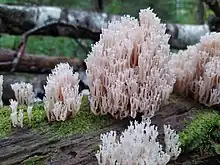Artomyces pyxidatus
Artomyces pyxidatus is a coral fungus that is commonly called crown coral or crown-tipped coral fungus. Its most characteristic feature is the crown-like shape of the tips of its branches. The epithet pyxidatus means "box-like"—a reference to this shape.[2]
| Artomyces pyxidatus | |
|---|---|
 | |
| Scientific classification | |
| Domain: | Eukaryota |
| Kingdom: | Fungi |
| Division: | Basidiomycota |
| Class: | Agaricomycetes |
| Order: | Russulales |
| Family: | Auriscalpiaceae |
| Genus: | Artomyces |
| Species: | A. pyxidatus |
| Binomial name | |
| Artomyces pyxidatus (Pers.) Jülich (1982) | |
| Synonyms[1] | |
| |
| Artomyces pyxidatus | |
|---|---|
| Smooth hymenium | |
| No distinct cap | |
| Hymenium attachment is irregular or not applicable | |
| Lacks a stipe | |
| Spore print is white | |
| Ecology is saprotrophic | |
| Edibility is edible | |
Artomyces pyxidatus can be observed throughout Northern Canada during the growing season. In Britain, it was recorded in 2011, almost 116 years after its previous reliable report, a collection made by mycologist Carleton Reale on 20 October 1886. Two subsequent records have been provided in Britain since 2011; one by Yvonne Davidson in Kent in 2018, and one by Cameron Ambler in East Sussex in 2021. It is widespread but uncommon in Western Europe. They are also widely found in the pine forest of northeastern India, known as the "eight sisters of India."
The fungus produces its hard, coral-like fruiting bodies on decaying wood. The colour ranges from cream to semi-tan.[3] The branches rise in ringlike arrangements resembling a crown.[3] Basidia and basidiospores are produced on the surfaces of the branches.
These fungi are considered edible when raw,[2] but are better cooked. The fungus are known to be served as meal amongst the tribal groups of Northeastern India since time immemorial. It is best served when fried with chopped potatoes.[4] It is usually found in quantities too small to make a meal.[5]
The sesquiterpenes compounds pyxidatols A-C, tsuicoline E and omphadiol have been obtained from the liquid culture of this fungus.[6]
DNA evidence and microscopy indicates that the species is closely related to members of the genera Russula and Lentinellus, as well as Auriscalpium vulgare.[3] Other similar species include Clavulina avellanea, C. cristata, C. divaricata, C. piperata, and C. taxophila.[3]
References
- "Artomyces pyxidatus (Pers.) Jülich 1982". MycoBank. International Mycological Association. Retrieved 2011-01-18.
- Henrici A, Mahler N (2012). "Artomyces pyxidatus refound in Britain". Field Mycology. 14 (1): 31–32. doi:10.1016/j.fldmyc.2012.12.009.
- Trudell, Steve; Ammirati, Joe (2009). Mushrooms of the Pacific Northwest. Timber Press Field Guides. Portland, OR: Timber Press. pp. 250–251. ISBN 978-0-88192-935-5.
- Meuninck, Jim (2017). Foraging Mushrooms Oregon: Finding, Identifying, and Preparing Edible Wild Mushrooms. Falcon Guides. p. 80. ISBN 978-1-4930-2669-2.
- Miller Jr., Orson K.; Miller, Hope H. (2006). North American Mushrooms: A Field Guide to Edible and Inedible Fungi. Guilford, CN: FalconGuide. p. 346. ISBN 978-0-7627-3109-1.
- Zheng Y-B, Lu C-H, Zheng Z-H, Lin X-J, Su W-J, Shen Y-M (2008). "New sesquiterpenes from edible fungus Clavicorona pyxidata". Helvetica Chimica Acta. 91 (11): 2174–80. doi:10.1002/hlca.200890235.
External links
 Media related to Artomyces pyxidatus at Wikimedia Commons
Media related to Artomyces pyxidatus at Wikimedia Commons- Clavicorona pyxidata at Tom Volk's Fungi